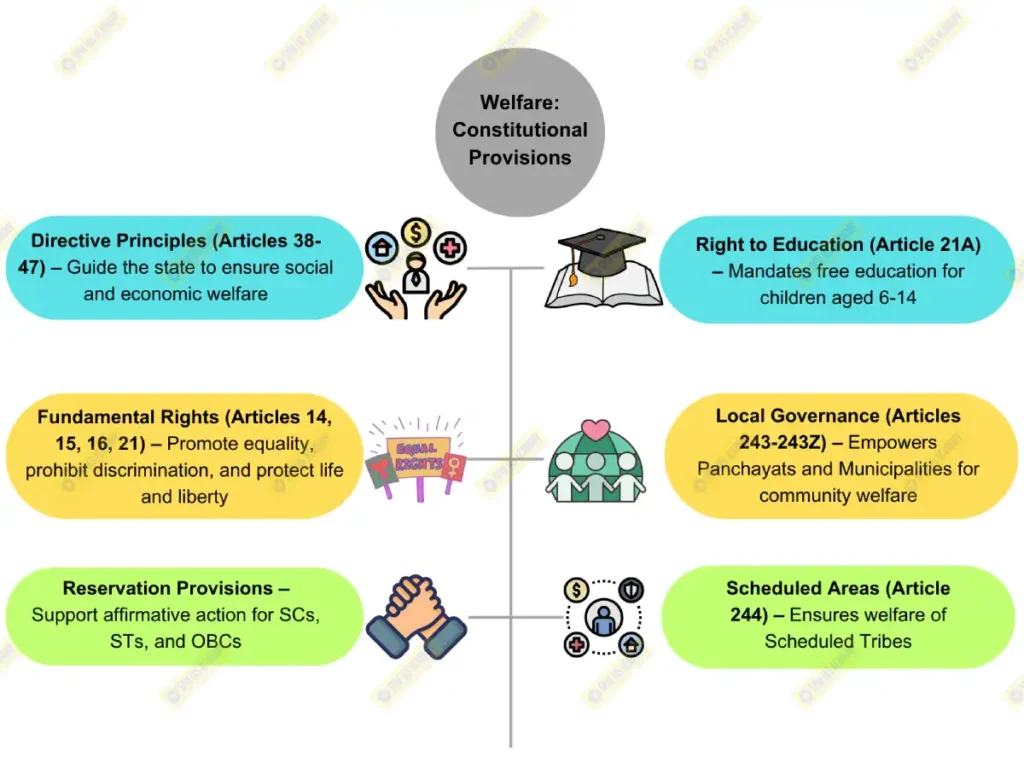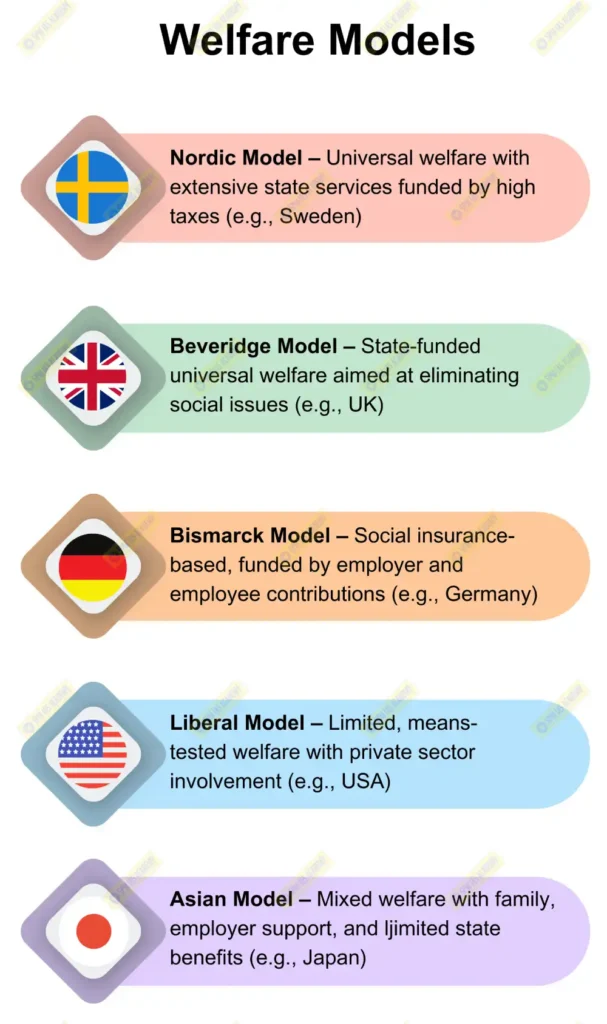The traditional welfare state model, established in the 20th century, focused on providing a “safety net” against market failures, poverty, and social inequities. However, in the 21st century, welfare states are evolving, moving from merely offering protective measures to empowering citizens to thrive in an increasingly competitive global environment. This shift reflects a transition from passive welfare provision to active welfare promotion aimed at enhancing competitiveness, responsiveness, and proactivity among citizens.
Key Aspects of the Evolving Welfare State
- Skills Development and Employability: Modern welfare states increasingly prioritize human capital development over mere income support. For example, the Skill India Mission launched by the Government of India aims to train over 400 million people in market-relevant skills by 2022, aligning social security with employability. Similarly, Germany’s Dual Vocational Training System combines theoretical education with practical training, equipping young people with skills that make them competitive in a rapidly changing job market.
- Universal and Inclusive Health Systems: Rather than solely offering protection against health risks, welfare states are investing in universal healthcare to improve productivity and responsiveness. India’s Ayushman Bharat Scheme provides health insurance to economically vulnerable citizens, aiming for 100 million families to access quality healthcare. This shift from “safety net” healthcare to “inclusive growth” healthcare recognizes that a healthy population is essential to an economically resilient society.
- Social Security for Gig and Informal Workers: With the rise of the gig economy and informal employment, welfare states now focus on inclusive policies for non-traditional workers. India’s Social Security Code, 2020, seeks to extend social protections to gig and platform workers, incentivizing their participation in the economy while ensuring they have access to benefits like health and retirement security. Similarly, California’s AB5 law aimed to provide gig workers with protections akin to full-time employees, though it faced pushback, underscoring the challenges welfare states face in balancing flexibility with security.
- Promotion of Digital and Financial Literacy: Modern welfare programs emphasize financial and digital inclusion to enhance citizen proactivity. India’s Pradhan Mantri Jan Dhan Yojana (PMJDY) has enabled over 500 million bank accounts for previously unbanked citizens, fostering financial inclusion and resilience. In tandem, Digital India seeks to equip citizens with digital skills to navigate an increasingly digitized world, promoting self-reliance and proactive engagement in economic activities.
- Support for Startups and Entrepreneurship: Welfare states are also facilitating entrepreneurship to promote economic competitiveness. India’s Startup India Initiative offers financial support, tax benefits, and incubation programs, encouraging citizens to engage in entrepreneurship as a pathway to economic security. Similarly, Israel has fostered a high-tech startup ecosystem, contributing to GDP growth and economic resilience, with government-backed support for R&D and innovation.
Contemporary Examples Reflecting This Shift
- Universal Basic Income (UBI) and Conditional Cash Transfers (CCTs): Welfare states are experimenting with policies like Universal Basic Income (UBI) to support citizens proactively. For instance, Finland’s UBI pilot provided citizens with a monthly allowance, encouraging job-seeking without the pressure of immediate financial need. Similarly, Brazil’s Bolsa Família program provides cash transfers linked to health and education conditions, enhancing citizens’ ability to contribute to society while addressing poverty.
- Lifelong Learning and Upskilling Programs: The Singapore SkillsFuture Program provides citizens with credits for upskilling, fostering a culture of lifelong learning that enables people to adapt to changing economic demands. This shift toward continuous learning makes citizens more responsive and adaptable in a globalized economy.
- Active Labor Market Policies (ALMPs): Many European countries, including Denmark, follow the flexicurity model, which combines flexible hiring and firing regulations with comprehensive training and social support for the unemployed. This approach creates a competitive labor force while ensuring that workers remain resilient amid economic fluctuations.
Criticisms and Challenges of the New Welfare Model
- Market Dependency: Critics argue that this new welfare model risks becoming overly dependent on market outcomes, sometimes at the expense of protecting the vulnerable. When welfare programs focus primarily on employability, those who cannot compete (due to age, health, or other barriers) may be left behind, leading to inequality.
- Pressure to Perform: There is concern that welfare states, by emphasizing productivity, may place undue pressure on citizens to constantly upskill and compete, risking social alienation and burnout. The shift may inadvertently erode the traditional safety net and create stress for individuals who may struggle to meet these demands.
- Sustainability and Inclusivity: Welfare policies must balance competitiveness with inclusivity. Programs like UBI or conditional transfers can be costly, and sustaining them requires robust economic performance. As welfare states evolve, they must ensure that vulnerable groups are not marginalized in the push for a more competitive citizenry.
Conclusion
Today’s welfare states are no longer merely safety nets but are actively transforming to equip citizens with the skills, health, and resources to thrive in an interconnected global economy. As Nobel Laureate Amartya Sen notes, “Development is about expanding the freedoms people enjoy.” Welfare states, therefore, seek to expand individual and collective capabilities rather than just shield from risks. By fostering competitiveness, responsiveness, and proactivity, modern welfare policies reflect a progressive shift, though they must carefully balance empowerment with protection to ensure inclusivity and resilience for all.













